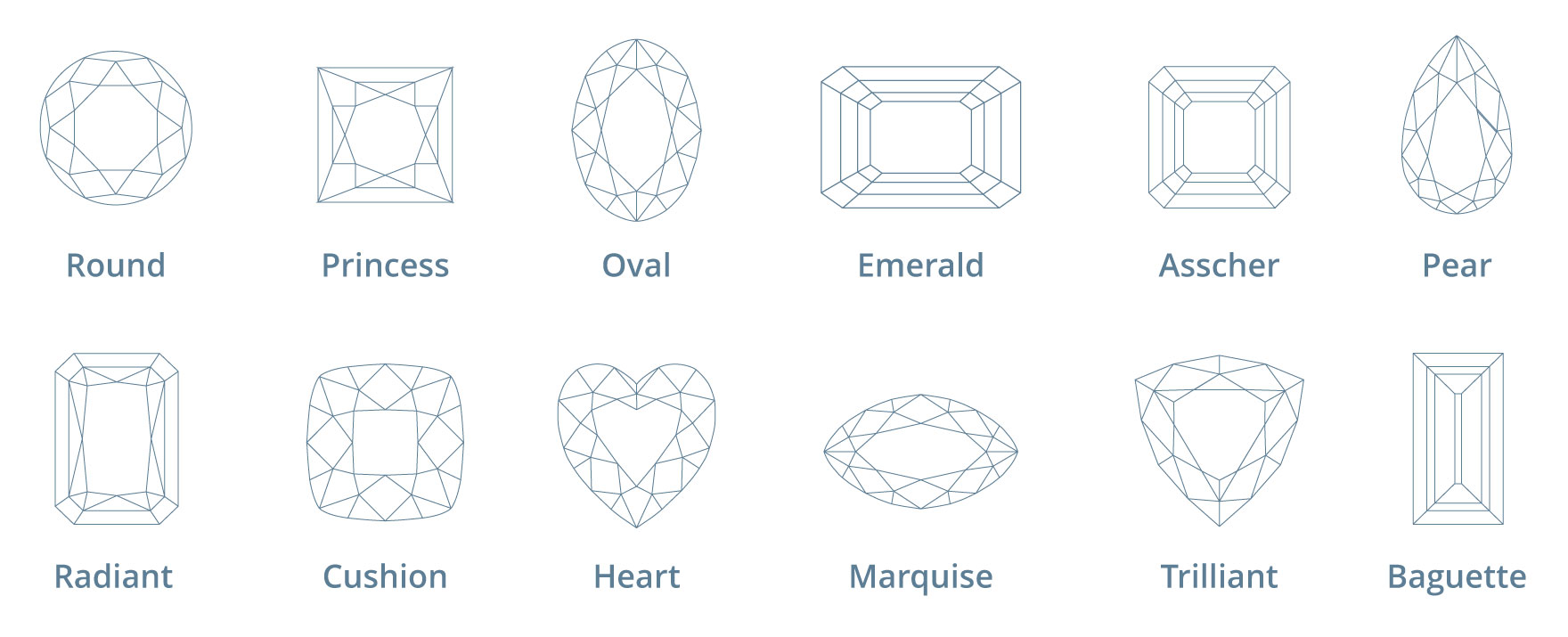In order to see the inherent beauty and ‘fire’ of a diamond it has to be meticulously polished and cleaved by a diamond cutter and cleaver. Once completed a gemmologist and jeweller can asses and grade the polished diamond. In the trade we refer to this as the 4cs.
Diamond cut
The ideal properties of a diamond are determined by positions and angles of the facets in relation to each other. The closer to the text book ideal, the angle and facets the better the grade of the diamond. For this reason Cut is the only one of the 4cs that is determined by mankind, where as the others are dictated by nature.

The cut also refers to the type of shape diamond – for example, round brilliant, square prince, emerald square asscher, pear shape, heart shape etc… These are also grade by ideal and specific criteria. Round diamonds are the classic and most popular cuts – although it is a matter of personal taste. When cut correctly traditionally with 57 or 58 facets (tiny planes that create angels and proportions of a stone to reflect light. It will reflect light from one facet to another; light will then be dispersed through the top of the stone resulting in optimum brilliance and fire. When cut too deep light will spill through the side or bottom and therefore resulting in less brilliance and fire. Note that less then 1 in 4 diamonds is cut to correct proportions. Cut is of prime importance because it determines the sparkle and value of a stone.
Colour
The first characteristic to stand out is the colour of the diamond. Colour is created by the absorption of white light, determined by the spectra of colours. Colour components are absorbed at different rates dependent on the chemical and atomic structure of the mineral.

Pure white diamonds appear colourless as nearly the entire wavelengths of the colour spectrum are absorbed equally. These diamonds are the most valuable as they are rarer and also reflect light most efficiently with the least interference. Various trace elements and irregular molecule structures can produce rare and fancy coloured diamonds. For example, traces of Boron will create fancy blue diamonds, whilst small amounts of nitrogen fancy yellow diamonds and deformation of the molecular structure, fancy pink diamonds.
White diamonds are graded on a colour scale ranging from D-Z, D being the whitest colour, Z the lowest – Yellow. From the letters L/M stones start to be graded in terms of their yellowness. Light/ faint yellow to fancy intense yellow. Generally diamonds with strong colours are called ‘fancies’ e.g. fancy yellow, red, green, blue etc… For white diamonds, D-I are the most sought after when making up jewellery in white gold or platinum. It is difficult to determine the subtle differences between two shades of colour, (eg E/F colour) even harder once the stones are set.
Carat
The weight of a diamond also determines its value – hence the heavier the more valuable when comparing like for like quality.

In metric terms 1ct = 200mg, or 1gramm = 5cts.
1 carat is made up of 100 points – therefore a half carat equals 0.50ct
Carat is a historical term; it derived from the word carob– carob seeds. These were used as a reference for diamond weight in ancient times, one carob equalled one carat. Note two diamonds of the same size can vary in value greatly depending on the other characteristics such as colour, clarity and cut.
Clarity
Diamonds were formed deep within the earth under variable pressure, temperature and cooling conditions. For this reason each stone is unique and has its own marks / naturally occurring inclusions or fingerprint characteristics. For example, fracture marks, tension cracks, clouds and even the presence of enclosed minerals and crystals are proof of these conditions.

Within the trade we refer to them as inclusions and they are used as identifying characteristics with which to grade the clarity of the diamond. We grade clarity on scale from F and IF (flawless and internally flawless) to the visible I (included), and is based on the visibility of inclusions at a magnification of x10. It is very rare for nature to produce perfectly clean or flawless stones and for this reason they are more valuable. In addition b/c there are no inclusions to interfere with the dispersing of light, hence the better the clarity, these stones when cut correctly will produce the most brilliance and fire. Generally without a 10x magnification/ microscope loop or more it can be difficult to see the inclusions, unless they are quite large. As a rule the smaller and fewer the inclusions the greater the value of the stone.
Comparison
When researching a diamond online – there is only so much you can tell. It is best to look at a selection of stones, side by side to determine how they actually look. More importantly one should place a stone btw ones fingers to get an impression of how it would look within the finished item of jewellery. Remember you are buying a diamond not a piece of paper.
